8 March 2017
It baffles me to observe a piece of chocolate being popped into one’s mouth, only to be instantly ground to smithereens. Hold on! How can chocolate be truly and thoroughly enjoyed if it’s just being chewed and swallowed? On this point, have you considered exactly what it is that attracts you to chocolate? Is it the aesthetics of the fancy packaging or glossy temper? The silky smooth texture? Perhaps the enticing aroma and sweet taste or a combination thereof?
If you’ve ever wanted to delve deeper to discover the root of your chocolate passion or obsession, the best place to start is by deriving complete enjoyment from every mouthful. While I’m by no means an expert in chocolate appreciation, here are some tips and lessons that I’ve picked up along my chocolate adventures.
Take Your Time
The act of consuming chocolate is not a competition or race. Pause, be in the moment and take the time to savour every mouthful.
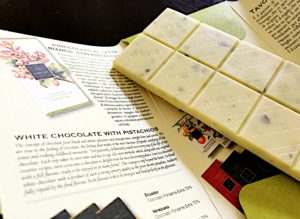 If available, make the effort to read the label or packaging to understand what it is you’re consuming, the ingredients that have gone into its production and the economic, social and environmental impact of the chocolate.
If available, make the effort to read the label or packaging to understand what it is you’re consuming, the ingredients that have gone into its production and the economic, social and environmental impact of the chocolate.
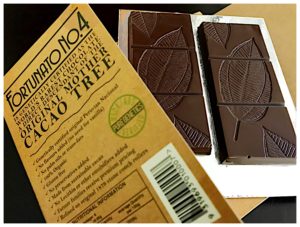 It’s also worth understanding the story of the cacao beans including the variety, region, country of origin, terroir and method of processing. If you’re a chocolate nerd like me, this will be enough to get you excited even before your first mouthful!
It’s also worth understanding the story of the cacao beans including the variety, region, country of origin, terroir and method of processing. If you’re a chocolate nerd like me, this will be enough to get you excited even before your first mouthful!
Connect With Your Senses
See, smell, hear, touch and taste the chocolate. Use all your senses to experience it.
See the Chocolate
Starting with your eyes, observe the colour. Is it dark brown, red brown, white or almost black?
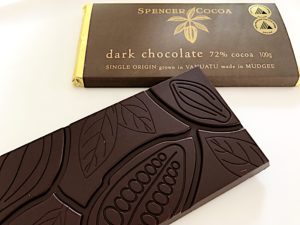 Look at the surface. Does it have a shiny, glossy sheen or looks dull with whitish or light brown spots? A shiny, glossy sheen is an indication of well tempered chocolate. Conversely, a dull surface with spots is likely to indicate bloom, either sugar bloom (sugar dissolves in moisture from condensation and crystallises upon its evaporation) or fat bloom (fat in the form of cocoa butter crystals deposit on the surface of the chocolate). Both are usually caused by suboptimal chocolate storage conditions and in the case of fat bloom, inadequate tempering. The chocolate is still nonetheless edible but obviously, this affects the overall experience. And on this note, an invaluable piece of advice to always bear in mind – avoid storing your chocolates in the fridge! The optimum storage temperature of chocolate is between 15 to 18 degrees Celsius.
Look at the surface. Does it have a shiny, glossy sheen or looks dull with whitish or light brown spots? A shiny, glossy sheen is an indication of well tempered chocolate. Conversely, a dull surface with spots is likely to indicate bloom, either sugar bloom (sugar dissolves in moisture from condensation and crystallises upon its evaporation) or fat bloom (fat in the form of cocoa butter crystals deposit on the surface of the chocolate). Both are usually caused by suboptimal chocolate storage conditions and in the case of fat bloom, inadequate tempering. The chocolate is still nonetheless edible but obviously, this affects the overall experience. And on this note, an invaluable piece of advice to always bear in mind – avoid storing your chocolates in the fridge! The optimum storage temperature of chocolate is between 15 to 18 degrees Celsius.
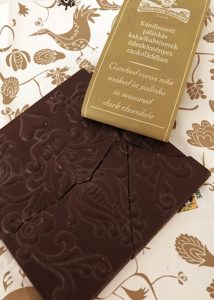 Admire the artistry of the colours, shapes and designs of the chocolate moulds. The latter can be both unique and beautiful, and provide a glimpse into the personality, heritage or background of the chocolate maker. Take for example the chocolate bars from Hungarian bean to bar maker Rózsavölgyi Csokoládé that are moulded to look like 19th Century Hungarian fire place tiles.
Admire the artistry of the colours, shapes and designs of the chocolate moulds. The latter can be both unique and beautiful, and provide a glimpse into the personality, heritage or background of the chocolate maker. Take for example the chocolate bars from Hungarian bean to bar maker Rózsavölgyi Csokoládé that are moulded to look like 19th Century Hungarian fire place tiles.
Smell the Chocolate
Put the piece of chocolate to your nose, like you would do with a glass of wine, and inhale deeply. Cup your hands around the chocolate and repeat a few times. What do you smell? Is it intense or faint?
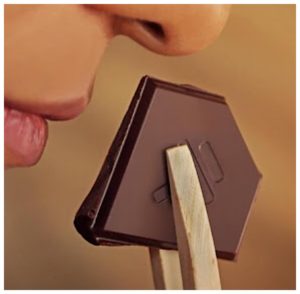
Try to associate the smells or aromas with common external stimuli like earth/ soil, trees, herbs, flowers and smoke to common foods like fruits, nuts, mushrooms, and sugar derived treats like caramel and toffee. It’s of course easier to do this with plain chocolates. The sensitivity and breadth of our sense of smell differs from individual to individual, so don’t worry if you smell something completely different to the next person.
Hear the Chocolate
For chocolate bars or squares, break a piece off. Does the chocolate break off with a short, sharp snap?
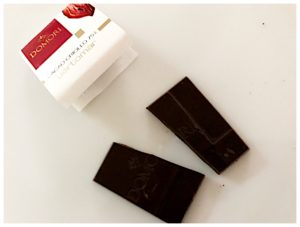
For bite-sized chocolates like pralines, ganaches and truffles, take a bite. Do you hear a short, sharp snap as you sink your teeth into it?
You should be able to hear the characteristic snap in well tempered chocolate.
Touch the Chocolate
Hold the piece of chocolate between your thumb and forefinger. Rub it and as it contacts the warmth of your fingers, it should start to melt. Is the texture smooth, gritty or uneven? Well conched chocolate should feel silky smooth to touch.

Place a bite-sized piece on your tongue and let it melt. Rub it between your tongue and the top of your palate. As the chocolate melts, does it have a smooth and even mouthfeel or gritty, lumpy texture? Well conched chocolate should have a very smooth and even mouthfeel. However, it’s normal for unconched, stone ground chocolate to be gritty, with an uneven texture.
Taste the Chocolate
Now, inhale deeply and as you exhale, begin to taste the chocolate. Is it sweet, sour/ acidic, bitter, astringent/ tannic or umami?
What flavours do you detect? Are they intense or faint? Are they similar to the aromas you’ve identified such as earthy, spicy, floral, smokey, fruity, nutty, caramel or toffee like, or completely different? For pralines, ganaches and truffles, can you taste the intended flavours?
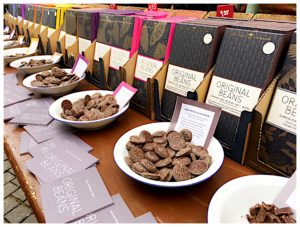 Are the flavours fleeting or do they build up and linger? Is the flavour profile flat or multi-dimensional and changes with time? It’s not unusual for the flavour profile of single origin and blended good quality chocolate to vary as the chocolate melts. The same holds true for “layered” pralines, ganaches and truffles.
Are the flavours fleeting or do they build up and linger? Is the flavour profile flat or multi-dimensional and changes with time? It’s not unusual for the flavour profile of single origin and blended good quality chocolate to vary as the chocolate melts. The same holds true for “layered” pralines, ganaches and truffles.
When all the chocolate has melted, does it leave an aftertaste in your mouth? Good quality chocolate should leave a clean finish with minimal aftertaste.
Bringing It All Together
When you consume your next mouthful of chocolate, give these basic chocolate appreciation tips a go.
Pause and get to know the chocolate you’re eating.
See, smell, hear, touch and taste it.
Once you’ve experienced the chocolate in its entirety, reflect on the outcome and revisit the question – what do you love about chocolate? You may be pleasantly surprised by what you discover!